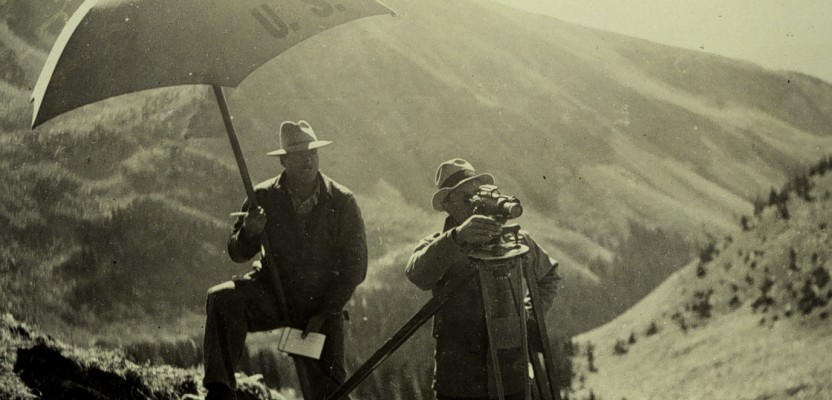As we ponder the many challenges presented by the rapid transformation of the land surveying profession, the topic of mentoring often comes up. I have written about that topic a couple of times in past editions of Field Notes.
(The image above is Whisky Pass Colorado, 1935. Credit: NOAA National Geodetic Survey.)
I attribute much of the reason for the loss of mentoring opportunities to the advancement of technology. However, as I look back on memorable moments of my career, one obvious lack of mentorship I experienced had nothing to do with technology or the advancement thereof. Misplaced faith in my abilities, possibly. Bad judgement, likely.
I was a young draftsman home for the summer from college. I had occasionally gotten tagged for field assignment as a grunt, and I even ran a level rod on a couple of occasions. I had never even looked through a surveying instrument of any type, though.
The company I worked for had a contract with the County to monitor the volume of the local landfill (we called it the dump), and the annual survey was due. However, our main crew was out of town on a pressing assignment and wouldn’t be back in time to perform the dump survey. For some reason, the PLS of the company decided that I could handle the task and told me to report ready for fieldwork the following day.
His son, three years my younger, was also working there for the summer and knew even less than I did about fieldwork, or surveying in general. Despite that, his dad teamed us up for the annual dump survey and took us to the site the following morning.
When we arrived, he showed me the bench mark I was to start from, which was near the toe of the compacted mountain of garbage. He grabbed some lath, spikes, and a cloth tape, and we walked up to the top of the fill. As we walked towards the upper reaches, he installed the spikes at 100’ intervals and set a lath near each, explaining that the spikes would be my “turning points,” and we would eventually be doing cross-sections at the 100’ stations. All of this terminology meant absolutely nothing to me, but I nodded as if I understood.
After laying out the stationing line, we went back to the truck and got out the level, tripod, and rod. He showed me how to set the level up and had me read the rod a couple of times just to make sure I was reading it correctly.
He then took out a field book and quickly showed me the format for keeping leveling notes. Plusses, minuses, something called an HI? I was totally clueless. He told me that, because I was starting and ending at the same point (bench mark), the number of entries in the plus and minus columns would be the same when we got done. We didn’t even do a quick loop as a training exercise. He asked, “Got it?” and he got in his truck and headed back to the office.
Now, this was 1980, so cell phones were only in James Bond movies. No calling the office from the dump.
The face of the compacted garbage mountain was steep, so right out of the chute we had tough setups and low and high rod turns on garbage. We crested the hinge point after several turns and started up the profile line, turning on the spikes. We got to the far one and started back. All seemed to be going okay.
We approached the slope and started down towards the bench mark when I realized that I had a lot more entries in one column than the other. I flashed on the PLS’s instructions about them being balanced, so I figured I better start adding them to the column that was obviously short so they would be even when we got to the bench mark.
We closed in, but I had no clue how to check anything, so we boxed it up and headed to the office.
Now, I was making something like $4.25/hour slinging ink in the office, but this was a prevailing wage job so I was getting paid the unbelievable amount of $19.55/hour to fumble my way over a mountain of compacted garbage. It was awesome!
When we got back in, I handed the PLS the field book, and he commenced to cyphering. He went through them once, then again, and didn’t look too pleased at the results. He then said, “Something is wrong. You mis-closed by 37.20 feet.”
I asked, fully exposing my ignorance, “Is that bad?”
He said, “Yes, very bad. It’s going to have to be redone.”
My response? “For $19.55 an hour?”
He said, “No, this time you will get rodman wages because I am running the crew.” That was still way above my regular pay.
Back to the dump we went. Yeehaw!!!
I learned a lot from that experience, including to be honest if I didn’t know or understand something, especially before the safety net was gone. I also learned the fundamental concept of differential leveling and performing cross-sections.
I told myself that day that when I became a mentor in the future, regardless of how much confidence I had in the person I was entrusting with a task, I would make sure they were clearly taught how to do it, that they displayed their understanding by doing it in my presence. Then I would check on them early and often.
That two-week paycheck was the biggest of my young career for many years. I still have that pay stub and those notes in a box of memorabilia somewhere. And, I stuck to the promise I made to myself that day.
At least that is what I would hope the people I have mentored would say.

